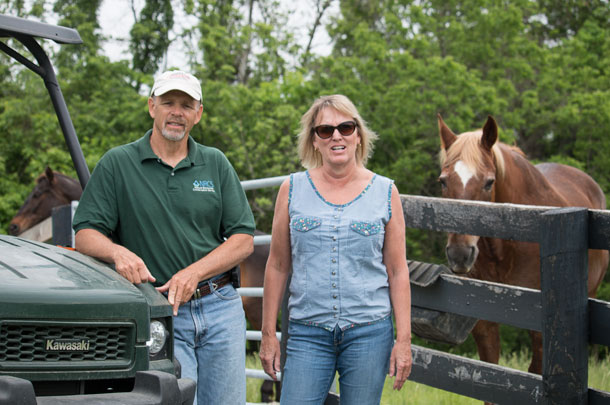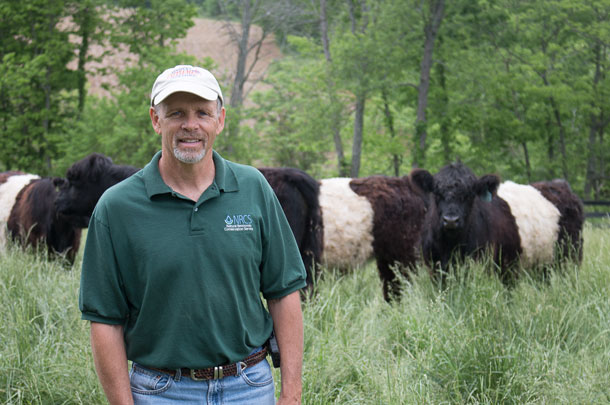Jon and Sylvia Bednarski raise grass-fed Belted Galloway cattle (or Belties) at Sherwood Acres in Oldham County and Henry County, Kentucky, and Harrods Creek runs through a portion of their property. Jon says, “The creek causes a lot of challenges, but cost-share conservation programs make it work.” He refers to having installed fencing and placed a riparian buffer zone along the creek in the NRCS Conservation Reserve Program.
The management plan included planting sycamore, oak and walnut trees along the creek bank to help hold the soil in place. Initially, it wasn’t as effective as he had hoped, because the creek flooded and took out some of the trees, and the deer helped themselves to some of the saplings. Bednarski knows the plan will be effective over time, but it’s been more difficult to achieve the goal than he had hoped.
In addition to the creek buffer zone, waterway crossings had to be installed to prevent creek bank erosion. For cattle, the crossings required excavation, then filling in with rip-rap (large rock), covering with a permeable, geotextile fabric, then adding smaller rock to fill the voids. Equipment crossings are similar, but a 10- to 12-inch thick apron is required at both entry and exit points to stabilize the banks.
Sylvia remains active in a group called the Harrods Creek Alliance, which works closely with the Kentucky Waterways Alliance to develop watershed plans that protect water quality and habitat on Harrods Creek. Harrods Creek crosses three counties and drains 92 square miles. Water quality became a concern around 1990 with 33 sewage treatment plants in the creek vicinity and contamination levels climbing. The Harrods Creek Watershed Project is manned with volunteers who regularly meet and methodically monitor water quality.
View a video of the conservation efforts at Sherwood Acres.

But the Bednarskis didn’t stop their conservation efforts with the creek. Jon says, “When we bought the land, there was nothing here but poorly managed woods and fallow ground. We’ve had to put in fences and develop the in-pasture watering systems, feed pads, and with NRCS we developed a pond for runoff. While the pond is great for aesthetics, it also slows water flow and we can pull from the pond to water the cattle if we need to.”
Some areas of the properties had rutted, barren grades that lost soil and created sediment concerns in the creeks. Bednarski rocked these old grades and reseeded them to help hold the soil.
Within the pastures, Bednarski developed a winter-feeding area with cedar trees to offer protection. This area fares poorly, compared with the rest of the pastures, because of heavy winter use. Bednarski considers these areas “sacrifice pastures,” but even here the pasture is reseeded every year to bring it back into production as much as possible. His motto: No bare soil. Bednarski says, “With the rolling landscape, it’s important to protect and cover the soil as much as possible.”
The Belted Galloway herd grazes a high percentage of Kentucky-31 fescue. Whenever possible, Bednarski seeds legumes into his pastures to dilute fescue toxicity. Common problems in the pastures, Bednarski says, are buttercup, multifloral rose, autumn olive, honeysuckle, black locust and other invasive trees and forbs. Spraying for these invasive plants can also kill the legumes, so it’s an annual job to keep pastures healthy, and it’s been a learning process. Bednarski says, “I learned pretty quickly that it’s easy to overstock a pasture, and it took us awhile to recover from that mistake.”
Bednarski’s conservation efforts of the past 13 years, however, have paid off. In addition to more efficient pasture production, Bednarski received the Oldham County Master Conservationist of the Year award in 2011 and the Master Conservationist of the Year for the entire state of Kentucky in 2012. In addition, he received the inaugural 2013 Leopold Conservation award for Kentucky and was the National Cattlemen’s Beef Association’s 2014 Region 1(17 state) recipient of their Environmental Stewardship Award.
Filling a niche market
Bednarski starting raising beef at the age of 48, after spending years in the log and timber frame business. He says, “We had wanted to get into the cattle business for some time, and I had researched what I thought would sell, and looked at what niche market we could provide. We’re a bedroom community to Louisville, and farmers markets do well here. So I looked at grass-fed Belted Galloways as a way to fill that niche in local markets.”
They started with a cow-calf herd in 2003, and when the housing market began to slow in 2006, they began direct marketing beef. Bednarski says, “The consumer wants to know what goes on behind our farm gates,” so they tailored their marketing campaign to provide that information. They began with “100-percent grass-fed beef” but quickly found they needed to modify their program.
Bednarski says, “We learned that grass-fed beef is extremely lean and required special preparation for maximum tenderness and flavor. Many consumers were not doing that and, as a result, did not have a good eating experience. So now, we supplement with a soy hull and corn gluten mix with 13 percent protein.”
The additional grain enhances the flavor and juiciness of the beef, leading to repeat customers and an increase in demand for their product.
Bednarski says, “Belted Galloways are predominantly a hobby breed and are unique from a marketing perspective. The cattle have a medium frame, and they’re not as selective in grazing as some cattle and do well on marginal forages. This niche breed, along with others, work well on small acreage farms, but do not sell well in the auction market like more mainstream breeds.”
Another major shift in the operation came a few years after the Bednarskis began direct marketing. The demand for their beef was outpacing the supply from their cow-calf operation, and the financial cost of expanding the herd to accommodate their needs was prohibitive. They sold their cow herd and now buy 6- to 8-month-old Belted Galloway steers from two larger farms, then turn them out on grass. The cattle finish at about 20 to 24 months old, at 1,050 to 1,400 pounds. They market directly to the consumer with 24 individual meat cuts. Bednarski says direct marketing provides the best profitability for their farm.
Bednarski got involved in the Belted Galloway Society in 2005, assisting with their marketing and promotion. He then served as president in 2012 and 2013, traveling the country and visiting fellow breeders to show support and to share his conservation effort ideas.
Jon and Sylvia regularly open their farm to the public for field days and other public events. Bednarski says, “We enjoy sharing our farm story with the public and consumers, but it’s also good marketing.” ![]()
To learn more, visit Sherwood Acres’ website.
PHOTO 1: This fenced cattle walkway between pastures requires a reinforced waterway crossing constructed with rip-rap and geotextile fabric.
PHOTO 2: Jon and Sylvia Bednarski raise cattle along Harrods Creek, Kentucky. Their water and soil conservation efforts include tree buffer zones, excavated and reinforced access points and water quality monitoring.
PHOTO 3: Jon Bednarski began his cattle operation with poorly managed woods and fallow ground. Through various grants and cost-share programs, he has reseeded barren grades, created a runoff pond and established a tree buffer zone along the creek. Photos by Lynn Jaynes.









